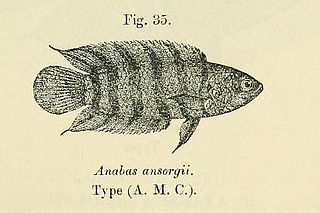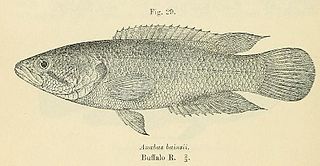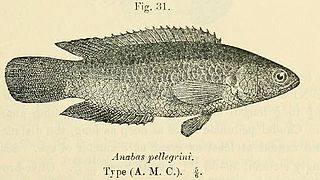
Chilochromis duponti is a species of cichlid endemic to riverine habitats in the Chiloango River basin of Cabinda Province of Angola and the Democratic Republic of the Congo, the Kouilou-Niari River and lower Loeme River in the Republic of Congo, and the Nyanga basin and upper Ngounie River which is part of the Ogooué system in Gabon. The main part of its diet is aquatic vegetation, largely algae, but small amounts of invertebrates are eaten. It is spawns on to the substrate. This species reaches a length of 30 centimetres (12 in) SL. It is the only currently known member of its genus. The specific name honours the Édouard Dupont (1841-1911), a Belgian geologist who was a pioneer of the geological exploration of the Congo Basin and a director of the Brussels Museum.

Microctenopoma ansorgii is a small freshwater fish, known in the aquarium trade as the ornate ctenopoma, orange ctenopoma, ornate climbing perch, pretty ctenopoma, or rainbow ctenopoma. It is related to the more familiar spotted climbing perch, but looks very different. Its body is more elongated and rounded, with fins with red and black stripes; the color intensifies when the fish are displaying, with black bars becoming visible on the body. The ornate ctenopoma spawns at night, laying its eggs on a floating bubble nest like its relatives in the osphronemidae. It lives in the slow-flowing forest streams of the Congo Basin, where it feeds on worms, insect larvae, and other aquatic invertebrates. It is the most common member of its genus in the aquarium trade, where it is known for being a shy, easily bullied fish that needs live or frozen foods and which benefits from the presence of smaller dither fish to encourage it to come out of hiding.
The mesh-scaled topminnow is a species of fish in the family Poeciliidae. The two population groups are a southern group of populations found in Angola, Botswana, the Republic of the Congo, Malawi, Mozambique, and Zambia and a northern population group found in Chad, the Central African Republic, the White Nile in South Sudan and Sudan and in the northern Democratic Republic of Congo. Its natural habitat is small streams and brooks, lakes, and swamps on floodplains where it lives among aquatic vegetation. This species was described by George Albert Boulenger as Haplochilus hutereaui in 1913 with the type locality being Dungu on the upper Uelé River in the Democratic Republic of Congo. Boulenger received the type from Armand Hutereau (1875-1914), who was the head of a Belgian ethnographic expedition to the Congo, so he honoured Hutereau in the specific name.

Haplochromis pappenheimi is a species of cichlid found in the Democratic Republic of the Congo and Uganda where it occurs in Lake Edward, Lake George and the Kazinga Channel. This species can reach a length of 6.1 centimetres (2.4 in) SL. The specific name honours the curator of fishes at the Royal Museum, Berlin Paul Pappenheim (1878-1945), who was the co-author of the paper in which this species was described.

Mastacembelus cunningtoni is a species of fish in the family Mastacembelidae. It is endemic to the Lake Tanganyika basin, including the Lakes outflow, the Lukuga River as far as the Kisimba-Kilia rapids. It occurs in Burundi, the Democratic Republic of the Congo, Tanzania, and Zambia. The specific name of this fish honours the British zoologist and anthropologist William Alfred Cunnington (1877-1958), leader of the expedition to Lake Tanganyika which collected the type.
Micralestes stormsi is a species of fish in the family Alestidae. It is found in Burundi, the Democratic Republic of the Congo, Tanzania, and Zambia. Its natural habitat is rivers.

Microctenopoma is a genus of fish in the Anabantidae family. They are native to Africa. Microctenopoma has been included in Ctenopoma in the past; unlike that genus, they are bubblenest builders, and the males defend the eggs and fry until they are free swimming.

The Eastern Province rocky, also known as rocky kurper, is a species of fish in the family Anabantidae. It is endemic to South Africa.
Atopochilus christyi is a species of upside-down catfish endemic to the Democratic Republic of the Congo. It occurs in the Ituri, Itimbri and Kasai Rivers as well as the Kinsuka Rapids and Boyoma Falls. This species grows to a length of 9.5 centimetres (3.7 in) SL.
Enteromius brazzai is a species of ray-finned fish in the genus Enteromius which occurs in the central Congo Basin and some other rivers in Gabon, Central African Republic and Cameroon.
Enteromius guirali is a species of cyprinid fish. It is endemic to Central Africa and occurs in Cameroon, Gabon, and the Republic of the Congo. It is a benthopelagic freshwater species that grows to 15.5 cm (6.1 in) total length.
Enteromius janssensi is a species of ray-finned fish in the genus Enteromius from the Democratic Republic of Congo.
Enteromius stanleyi is a species of ray-finned fish in the genus Enteromius which is endemic to the Congo River system in the Democratic Republic of the Congo.

Betta enisae is a species of gourami endemic to the Kapuas River basin of Indonesia. It is an inhabitant of forest streams with slightly acidic waters, and can mostly be found in the shallows amongst the leaf litter. This species grows to a length of 5.9 cm (2.3 in). It is commonly used as bait by local fishermen and has been found in the aquarium trade. The specific name of this fish honours Enis Widjanarti who assisted Kottelat in his expedition to the Kapuas Lakes.
Parablennius verryckeni is a species of combtooth blenny found in the eastern Atlantic ocean from Congo to Sierra Leone. This species reaches a length of 4.9 centimetres (1.9 in) TL. The specific name honours the radio and telegraph operator and sports fisherman C. Verrycken of Banana Creek in the Democratic Republic of the Congo Poll said collected “many interesting specimens” for him.

Polypterus weeksii, the mottled bichir, is a fish in the family Polypteridae found in the central basin of the Congo River. It grows to about 54 cm in head-to-tail length.

The Malay combtail is a species of gourami native to southeast Asia where it is found in peat swamps of the Malay Peninsula and the Greater Sunda Islands. This species can reach a length of 20 centimetres (7.9 in) SL. It is a commercially important species and is also found in the aquarium trade. This species was formally described by Georges Cuvier in 1831 with the type locality of Java. The collector of the type was collected in 1820 by the Dutch physician and biologist Johan Coenraad van Hasselt (1797-1823), whom Cuvier honoured in its specific name, with his friend Heinrich Kuhl.

Ctenopoma pellegrini is a fish in the family Anabantidae found in the Congo River basin of Africa. It grows to 11.2 cm in total length for a male/unsexed specimen. This species was formally described by the British-Belgian ichthyologist George Albert Boulenger in 1902 with the type locality given as Yembe River at Banzyville in the Democratic Republic of Congo. Boulenger honoured the French ichthyologist Jacques Pellegrin (1873-1944).

Orthochromis stormsi is a species of cichlid endemic to the Democratic Republic of the Congo, where it is known from the upper Congo River basin and Lake Mweru. It has also been reported from Pool Malebo and the Regina Falls in the lower Congo River basin, but the identity of these populations requires further investigation. This species can reach a length of 10.2 centimetres (4.0 in) SL. The specific name honors the Belgian Army Lieutenant Maurice Joseph Auguste Marie Raphael Storms (1875-1941) who collected the type which he presented to the Brussels Museum.

Nothobranchius brieni is a species of brightly colored fish in the family Nothobranchiidae. It is endemic to freshwater habitats in the south-eastern parts of the Democratic Republic of the Congo.












